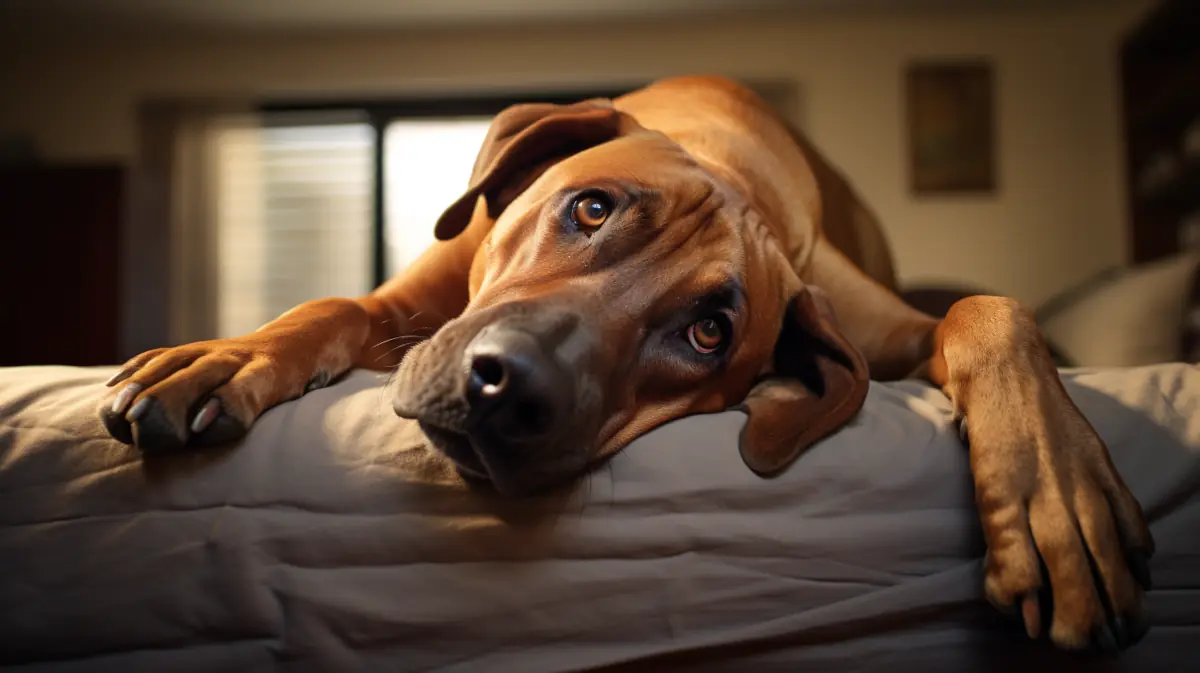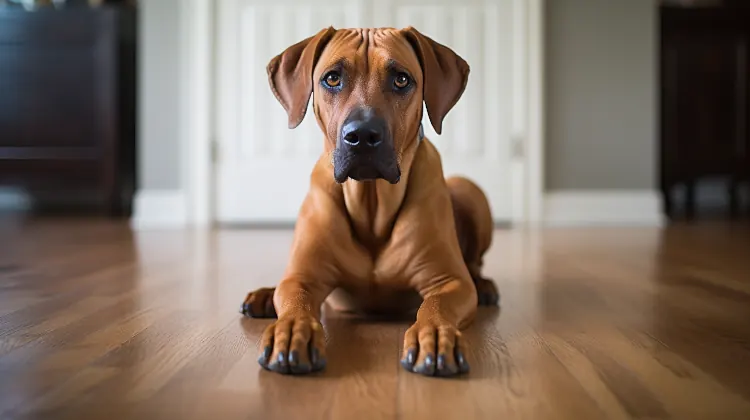Rhodesian Ridgebacks are known for their short, dense coats that require minimal grooming. While they don’t shed excessively, some coat care is still required to keep your Rhodesian Ridgeback looking and feeling their best. In this complete guide, we’ll cover everything you need to know about Rhodesian Ridgeback shedding and coat care.
Key Takeaways:
- Rhodesian Ridgebacks require regular coat care to manage shedding: Brushing their coat regularly helps to remove loose fur and reduce shedding.
- Nutrition plays a role in your Rhodesian Ridgeback’s coat health
- Allergies can contribute to shedding in the Rhodesian Ridgeback
- Excessive shedding may indicate an underlying health issues
Table of contents
Rhodesian Ridgeback Coat Care
To properly care for your Rhodesian Ridgeback’s coat, follow these tips:
- Regular brushing: Brush your Rhodesian Ridgeback’s coat at least once a week to remove loose hair and prevent shedding.
- Bathing schedule: Maintain a regular bathing schedule for your Rhodesian Ridgeback, using a gentle dog shampoo. Avoid over-bathing, as it can strip the natural oils from their coat.
- Nutritious diet: Provide a balanced and nutritious diet for your Rhodesian Ridgeback, as their coat health is influenced by their overall well-being.
In addition to these care routines, ensure your Rhodesian Ridgeback gets regular exercise and check their coat for any signs of skin issues. By following these guidelines, you can keep your Rhodesian Ridgeback’s coat healthy and glossy.
Don’t miss out on the opportunity to maintain your Rhodesian Ridgeback’s coat in its best condition. Invest time and effort into regular brushing, bathing, and a nutritious diet. Your Rhodesian Ridgeback will not only boast a lustrous coat but also feel happier and healthier overall.
Nutrition and Your Dog’s Coat

A dog’s coat is greatly influenced by its nutrition. Understanding the connection between nutrition and your dog’s coat is crucial for maintaining its health and appearance. Here are five key points to consider:
- Essential Nutrients: Adequate intake of essential nutrients such as omega-3 fatty acids, vitamins A and E, and biotin is vital for promoting a healthy and shiny coat.
- Protein Quality: A high-quality protein source in your dog’s diet helps to support the growth and maintenance of a thick and lustrous coat.
- Hydration: Sufficient water intake is necessary for maintaining skin health, which directly impacts the quality of your dog’s coat.
- Digestive Health: Good digestion ensures proper nutrient absorption, which contributes to the overall health and shine of your dog’s coat.
- Allergies: Certain food allergies or sensitivities can manifest as skin and coat issues in dogs. Identifying and eliminating potential food allergens can help improve coat condition.
Additionally, it is important to consider the specific nutritional needs of your dog’s breed and age. Regular grooming and regular vet check-ups also play a significant role in maintaining a healthy coat.
In relation to nutrition and your dog’s coat, it is interesting to note that a Rhodesian Ridgeback owner noticed a remarkable improvement in their dog’s coat after switching to a diet rich in omega-3 fatty acids and high-quality protein. The owner’s careful attention to nutrition highlights the direct impact it can have on a dog’s coat health.
Allergies and Shedding
Allergies and shedding in Rhodesian Ridgebacks can be a common concern for owners. Understanding the connection between allergies and shedding can provide insights into how to manage this issue effectively. Here are four key points to consider:
- Allergy-related shedding: Rhodesian Ridgebacks with allergies may experience increased shedding due to the body’s immune response. Allergens can trigger the release of histamines, which can result in excessive shedding.
- Skin irritation: Allergies can lead to skin irritation in Rhodesian Ridgebacks, causing them to scratch and bite at their fur. This scratching can further contribute to shedding as it damages the hair follicles and leads to hair loss.
- Dietary factors: Certain ingredients in your Rhodesian Ridgeback’s diet can potentially trigger allergies and contribute to shedding. Identifying and avoiding these allergens can help alleviate the issue.
- Environmental allergens: Pollen, dust mites, and other environmental allergens can also affect Rhodesian Ridgebacks, leading to itching, skin irritation, and shedding. Regular cleaning and minimizing exposure to these allergens can provide some relief.
In addition to the above points, it’s important to regularly groom your Rhodesian Ridgeback to manage shedding. By brushing them frequently and using appropriate grooming tools, you can help remove loose hair and reduce shedding. Ultimately, understanding the specific allergens and implementing suitable measures can significantly help in minimizing shedding in Rhodesian Ridgebacks.
Excessive Shedding in Rhodesian Ridgebacks

Rhodesian Ridgebacks are prone to excessive shedding, which can be quite a concern for their owners. Understanding the reasons behind this shedding is essential in managing it effectively.
- Genetic Factors: Rhodesian Ridgebacks have a single coat with a unique ridge of hair along their back. This distinctive feature contributes to their shedding tendencies.
- Seasonal Changes: Just like other breeds, Rhodesian Ridgebacks shed more during certain times of the year, especially during spring and fall, when they prepare for temperature changes.
- Natural Hair Cycle: Dogs, including Rhodesian Ridgebacks, have a natural hair growth cycle that includes shedding old and damaged hair. This shedding helps in the renewal and overall health of their coat.
- Health Conditions: Excessive shedding in Rhodesian Ridgebacks may also be indicative of underlying health issues such as allergies, hormonal imbalances, or skin infections. Consulting a veterinarian is crucial in ruling out any possible health concerns.
- Dietary Factors: Nutrition plays a significant role in a dog’s overall health, including the condition of their coat. A balanced and high-quality diet can minimize excessive shedding in Rhodesian Ridgebacks.
- Grooming Practices: Regular grooming, including brushing and bathing, helps in managing shedding by removing dead hair and maintaining a healthy coat. It also promotes better circulation and healthier hair growth.
Furthermore, it is vital to note that excessive shedding in Rhodesian Ridgebacks can vary from dog to dog. Individual factors like age, overall health, and environmental conditions can influence the extent of shedding.
Pro Tip: To minimize shedding in Rhodesian Ridgebacks, make sure to provide a well-balanced diet, maintain regular grooming practices, and monitor their health closely. Seeking guidance from a professional groomer or veterinarian can also greatly help in managing excessive shedding.
Conclusion and Final Thoughts
Rhodesian Ridgebacks are somewhat prone to shedding. Regular grooming, such as brushing and bathing, can help manage the shedding. Additionally, a healthy diet and proper nutrition can play a role in reducing excessive shedding. Implementing these strategies can significantly minimize shedding in Rhodesian Ridgebacks.
Furthermore, it is important to note that shedding can also be influenced by factors such as seasonality and hormonal changes. For example, during certain times of the year, Rhodesian Ridgebacks may shed more to adjust to temperature variations. Spaying or neutering can also affect the shedding pattern in these dogs.
FAQs about Why Is My Rhodesian Ridgeback Shedding
The Rhodesian Ridgeback is a breed with a short, smooth coat that sheds only moderately throughout the year. However, if your Rhodesian Ridgeback is shedding excessively and showing signs of dry, flaky, itchy, or sore skin, there may be an underlying cause such as parasites, a low-quality diet, incorrect bathing rituals, stress, allergies, skin infections, tumors, hormonal imbalances, or autoimmune disorders. It is important to consult with a vet if you notice abnormal shedding.
No, Rhodesian Ridgebacks are not considered hypoallergenic. While they shed less than some other breeds, they still shed and can potentially trigger allergic reactions. If you are looking for a low-shedding dog due to allergies, consider breeds such as Poodles, Portuguese Water Dogs, Spanish Water Dogs, Schnauzers, Bichon Frises, or Maltese.
Seasonal shedding in Rhodesian Ridgebacks, and many other breeds, is a normal occurrence. During spring and fall, dogs tend to shed more as they change their coat to adapt to the changing weather. If your Rhodesian Ridgeback is shedding more during these seasons but is otherwise healthy, it is likely just a natural part of their shedding cycle.
Q. To manage your Rhodesian Ridgeback’s shedding, regular brushing is essential. Use a bristle brush to remove any dead hairs and distribute the natural oils produced by their skin, helping to maintain a glossy coat. Additionally, feeding them a high-quality diet rich in protein, essential fatty acids, vitamins, and minerals is crucial for a healthy skin and coat. If your Rhodesian Ridgeback has underlying skin conditions or is shedding excessively, consult with your vet for appropriate care.
Bathing your Rhodesian Ridgeback should be done only when necessary, such as if they get dirty. Overbathing can dry out their skin and cause itchiness and soreness. However, if your Rhodesian Ridgeback has a skin condition, your vet may prescribe more frequent bathing with a special shampoo. Remember to use dog-specific shampoo and thoroughly rinse to maintain a healthy coat and skin.
Managing a Rhodesian Ridgeback’s shedding doesn’t require a lot of grooming tools. A bristle brush is sufficient for weekly brushing to remove dead hairs. You may also consider using a de-shedding tool, especially during shedding seasons, to help with the removal of loose hair. However, it is important to brush your Rhodesian Ridgeback thoroughly and regularly to maintain a healthy skin and coat.





